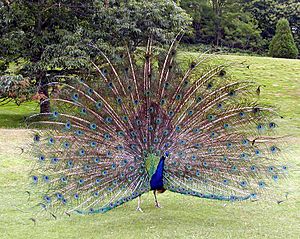Secondary sex characteristic facts for kids

Have you ever noticed how male and female animals of the same kind often look different? These differences are called secondary sex characteristics. They are features that help us tell males and females apart, but they are not directly involved in making babies (reproduction). Think of them as extra features that show off whether an animal is male or female.
Contents
What Are Secondary Sex Characteristics?
Secondary sex characteristics are physical traits that appear during puberty or when an animal grows up. They are not the main parts of the body used for reproduction, but they are important for things like attracting a mate or competing with others. These traits are often controlled by hormones, which are special chemicals in the body.
Examples in the Animal Kingdom
Many animals show clear secondary sex characteristics. These differences can be very obvious, helping animals find partners or show off their strength.
Birds and Their Bright Colors
In the world of birds, males often have much more colorful feathers, also known as plumage. For example, a male peacock has a huge, bright tail that he uses to impress females. Female birds, on the other hand, usually have duller, more camouflaged feathers. This helps them hide from predators while they are nesting and raising their young. The male's bright colors might make him stand out, but they also show how healthy and strong he is.
Deer and Their Antlers
Male deer often grow large antlers. These antlers are a great example of a secondary sex characteristic. They are not used for reproduction, but male deer use them to fight other males for territory or to win over females. The size and strength of a male's antlers can show how strong and fit he is. Females do not usually grow antlers, or if they do, they are much smaller.
Lions and Their Manes
Male lions are famous for their large, shaggy manes around their heads. This mane makes them look bigger and more powerful. It helps them attract female lions and can also make them seem more intimidating to other male lions they might compete with. Female lions do not have manes.
Secondary Sex Characteristics in Humans
Humans also have secondary sex characteristics that develop during puberty. These traits help distinguish males from females.
Changes in Boys
When boys go through puberty, their bodies change in several ways. Their voices become deeper, and they start to grow facial hair like mustaches and beards. They also tend to develop a more muscular build. These changes are influenced by hormones like testosterone.
Changes in Girls
Girls also experience many changes during puberty. Their breasts become more prominent, and their hips often widen. They tend to have softer skin and a higher voice compared to boys. Their hair might grow longer and faster. These changes are influenced by hormones like estrogen.
Why Are These Differences Important?
Secondary sex characteristics play a big role in sexual selection. This is a type of natural selection where certain traits help an individual find a mate and successfully reproduce. For example, a peacock with a magnificent tail might be more attractive to a female peacock, meaning he is more likely to have offspring. These traits can also help animals compete with others of the same sex for resources or mates.
Related topics
See also
 In Spanish: Caracteres sexuales secundarios para niños
In Spanish: Caracteres sexuales secundarios para niños


